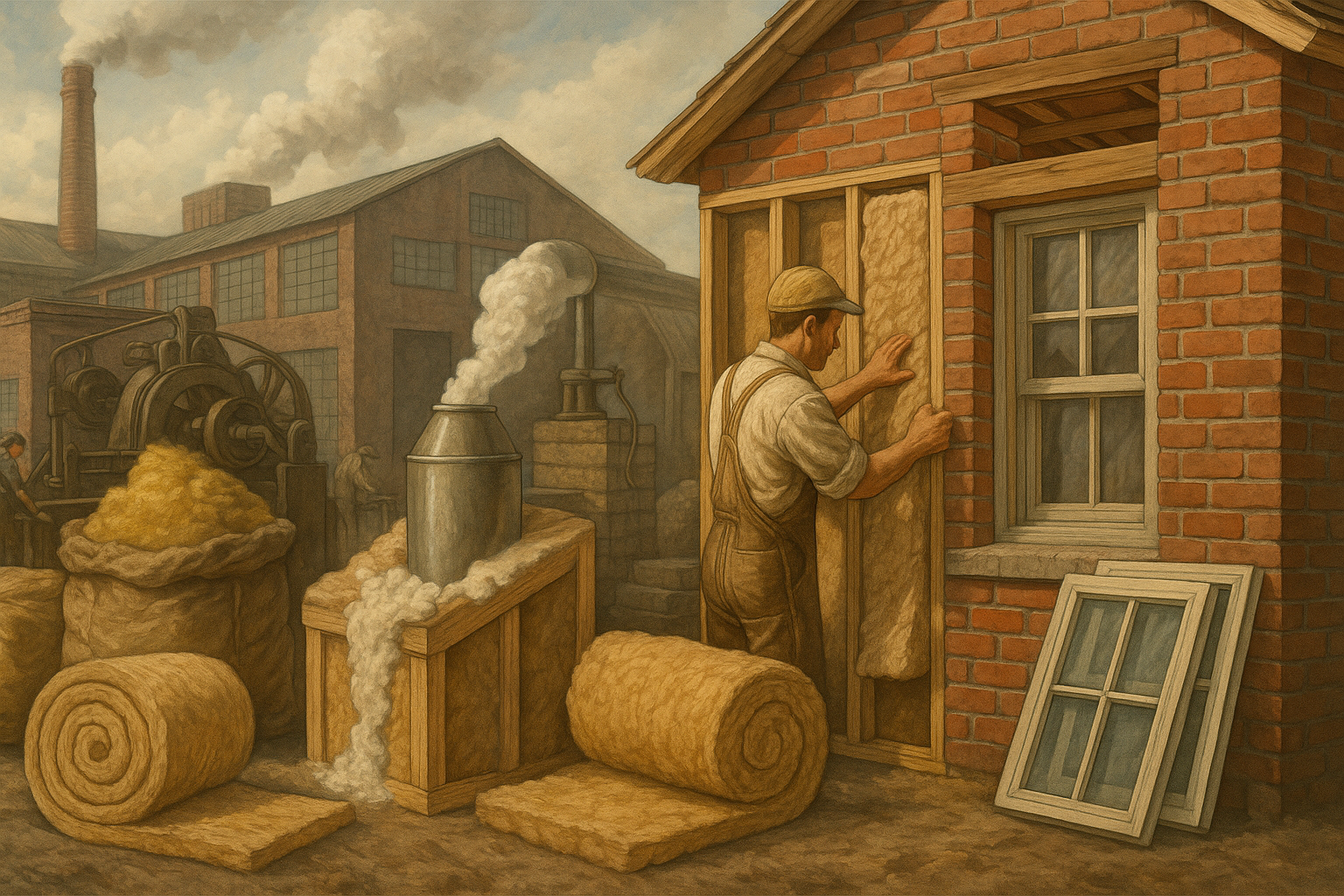The Industrial Revolution didn’t just change factories and cities. It also changed how we build and keep our homes warm or cool. Before the 18th century, people used simple materials like straw, mud, or animal hair to stop cold air from getting inside their homes. It worked okay, but it was far from perfect. Then came the Industrial Revolution. New machines, new materials, and mass production changed everything about building insulation.
At Advance Insulation Canada, we know how important good insulation is, especially in Canada’s tough climate. Whether you live in Victoria, BC, or Fort McMurray, AB, having the right insulation can make your home much more comfortable and save you money on energy bills. In this article, I’ll explain how the Industrial Revolution helped create the insulation methods and materials we use today.
How People Insulated Homes Before the Industrial Revolution
Before the rise of factories and machines, people insulated their homes with natural materials they had nearby. There were no insulation products or modern building standards. Everything was done by hand, using local knowledge and resources.
In colder parts of Europe and North America, people often stuffed straw or sheep’s wool between the wooden beams of their homes. Wool was a popular choice because it’s naturally warm and could be packed into wall spaces. In some Nordic regions, dried moss was used to fill the gaps between logs in log cabins. It acted as a natural sealant against cold air and snow.
In England and other parts of Europe, “wattle and daub” was common. This technique involved weaving wooden sticks together (wattle) and covering them with a mixture of clay, sand, and straw (daub). While this offered some thermal mass and protection, it didn’t truly insulate in the way we understand today.
In poorer rural areas, people used whatever they could. Animal hair mixed with mud or even seaweed was used in wall construction. In Scotland, for example, thatched roofs made of straw or reeds helped trap some warmth inside cottages during winter months.
Walls were often very thick, sometimes up to two feet wide, especially if made of stone or brick. This thickness helped keep out wind and rain but didn’t stop heat from slowly escaping. Without sealed windows or doors, even the best-built homes lost heat quickly in winter and became stuffy in summer.
There were no set rules for how to insulate a house. Everything depended on the builder’s skill and the natural materials available. While these early methods helped people survive cold seasons, they weren’t very effective. Comfort levels were low, and there was no real way to control indoor temperatures or save fuel.
What the Industrial Revolution Changed About Building Insulation
The Industrial Revolution began in the late 1700s and went on through the 1800s. It brought big changes to how materials were made and how houses were built. Here are some of the biggest changes that helped building insulation improve:
- Mass Production of New Materials
Factories started making building materials like bricks, glass, and cement in large amounts. These materials were stronger, cheaper, and more uniform than the ones made by hand. This made it easier and faster to build better homes.
More importantly for insulation, new materials like mineral wool and cellulose fiber started to be made in factories. These materials could be produced in large quantities and used to insulate entire walls and ceilings instead of just small areas.
- Standardized Building Methods
Before the Industrial Revolution, every house was built differently. But with mass production, builders got access to materials that were the same size and quality every time. This helped builders make homes with fewer gaps and cracks where heat could escape.
This change meant insulation could be planned and installed when the house was built, instead of added later in a patchy way.
- Use of Steam Power and Machines
Steam engines powered machines that could make insulation materials faster and better. This lowered the price and made good insulation available to more people.
- Growing Cities and New Comfort Needs
As many people moved to cities for work, they wanted homes that kept them warm in winter and cool in summer. This growing demand pushed companies to find better insulation solutions.
New Insulation Materials from the Industrial Revolution
Some of the new materials made during the Industrial Revolution are still important in insulation today:
- Mineral Wool
Mineral wool, also known as rock wool or stone wool, was developed in the late 1800s. It is made by melting rocks or industrial waste like slag (a byproduct from metal production) and spinning them into fine fibers. These fibers trap air and reduce heat flow, making mineral wool excellent for insulation. It also does not burn easily, which makes it a safe choice for fire-resistant construction. Today, mineral wool is commonly used in walls, ceilings, and floors.
- Spray Foam Insulation
Spray foam insulation became possible thanks to advances in chemical manufacturing that began in the late Industrial era and developed more fully in the 20th century. Spray foam is made by mixing liquid chemicals that expand into a thick foam when sprayed. It fills cracks and gaps that other types of insulation can’t reach. Spray foam not only blocks heat loss but also stops air and moisture from getting in. It is often used in basements, crawlspaces, attics, and between walls.
- Protective Coatings
Protective coatings for insulation, such as vapor barriers and reflective foils, were made possible through chemical innovations that began during the Industrial Revolution. These coatings help protect insulation from moisture and mold, which can lower its effectiveness. Reflective coatings also bounce heat away from the home, which is helpful in warmer climates.
- Attic Insulation
As home design improved during and after the Industrial Revolution, builders began to focus more on attics. Heat rises, so an uninsulated attic leads to major heat loss. New materials like mineral wool and cellulose were installed in attic floors and walls to keep warmth inside the living space. Today, many homes use fiberglass batts, spray foam, or blown-in cellulose to insulate attics.
- Cellulose Fiber
Cellulose insulation became more common in the 19th century as paper production increased. It is made from recycled newspaper and other paper products. The paper is shredded and treated with fire-retardant chemicals to make it safe for use in homes. Cellulose is lightweight and easy to blow into wall cavities, attics, and tight spaces. It is a cost-effective and eco-friendly way to keep buildings warm in winter and cool in summer.
- Glass and Double-Paned Windows
The Industrial Revolution also made it possible to produce glass faster and in larger sheets. This led to the invention of double-paned windows, which trap air or special gases between two glass panes. These windows reduce heat loss much better than the old single-pane windows.
How These Changes Affect Home Insulation Today
The Industrial Revolution set the stage for how we insulate buildings now. Here’s how:
- Energy Efficiency Became Important
In the past, insulation was mostly used just to stay warm. But after the Industrial Revolution, people began to focus more on saving energy and cutting down heating and cooling costs. Today, good insulation helps keep homes warm in the winter and cool in the summer, using less energy.
This shift also led to the creation of programs that reward energy-saving choices. Many homeowners now qualify for energy rebates when they install better insulation, energy-efficient windows, or other improvements. These rebates help lower the upfront cost and encourage people to make their homes more efficient.
- More Affordable and Reliable Insulation
Mass production made insulation materials cheaper and more consistent in quality. This means more homeowners could afford to add insulation that really works.
- Building Codes and Standards
As building materials became standardized, governments started making rules about how buildings should be insulated. These rules protect homeowners by making sure new houses keep energy costs down and stay comfortable.
- Better Comfort for Homeowners
Thanks to the new materials and methods from the Industrial Revolution, modern homes stay cozy even in the coldest winters or hottest summers. This improves quality of life and reduces heating and cooling bills.
Why This Matters in Canada
Canada has some of the harshest winters in the world. That means home insulation isn’t just a nice-to-have; it’s essential. The lessons from the Industrial Revolution about good insulation help companies like Advance Insulation Canada provide the best solutions for Canadian homes.
Whether you live in rainy Victoria, freezing Fort McMurray, or anywhere in between, proper insulation can protect your home from cold drafts and help keep energy costs low. Our team understands the unique challenges Canadian homeowners face and uses the best materials and techniques developed over centuries of innovation.
Ready to Upgrade Your Insulation? Call Advance Insulation Canada Today
If you’re living in Victoria, BC, Fort McMurray, AB, or anywhere in between, your home deserves insulation that’s built for the Canadian climate. At Advance Insulation Canada, we understand the unique weather challenges in your area.
Whether you’re building a new home or upgrading an older one, we offer trusted insulation solutions including spray foam, attic insulation, and protective coatings. Our team uses the latest materials and techniques to improve your home’s comfort, reduce energy bills, and increase long-term value.
Call us now at 1-855-531-FOAM. Let’s talk about how we can help make your home more energy-efficient, cozy, and safe year-round. We proudly serve local communities across British Columbia and Alberta with professional, reliable service. Let’s get started!

